#siglo ix
Text
youtube
LA ABADESA (2024)
Synopsis
In the 9th century, Emma of Barcelona (c. 880-942), a 17-year-old girl, is named abbess in order to repopulate and Christianize border territories in 897. Upon arriving at the abbey, she will have to overcome the mistrust aroused by a woman determined to fulfill her mission, which will lead her to confront nobles, like her brother Count Guifré II Borrel of Barcelona (874-911), peasants and the nuns themselves. Despite everything, Emma will show that it is possible to challenge established power structures. Although she will pay a high price to get it...
Emma is willing to carry out the commission of her deceased noble father, Count Guifré I of Barcelona, Guifré el Pilós (840-897), founder of the House of Barcelona: convert the abbey that he founded in 885, the Monastery of Sant Joan de les Abadesses, for which she is now responsible into the engine of change and transformation of a society that comes down. She must help with all her resources to help the lands that are emptied due to hunger caused by border wars, which in turn are a consequence of the ambitions of the feudal lords of the area.
Emma acquired small or large properties with which the monastery came to have a territory equivalent to that of a county. Her sovereignty was also similar to that of a countess: by concession from her father, her domains were exempt from all interference from the neighboring counts, whom she knew how to oppose with resistance.
On cinemas: Friday 22 March
Filming began in January 2023 at the Loarre Castle, and included scenes filmed at the Turó de la Seu Vella, until concluding at the end of February 2023.
Main cast
Emma of Barcelona - Daniela Brown
Eloisa - Blanca Romero
Guifré II Borrel of Barcelona - Carlos Cuevas
Eduard - Ernest Villegas
Odón - Oriol Genís
Bishop Gotmar of Vic– Joaquín Notario
Clara-Berta Sánchez Bajona
Melisenda - Anäel Snoek
Elvira- Olivia Auclair
Data sheet
Script and direction: Antonio Chavarrías
Produced by: Antonio Chavarrías, Jose María Morales, Miguel Morales, Mónica Lozano
Photography direction: Julian Elizalde
Editing: Clara Martínez Malagelada
Music: Ivan Georgiev
Casting: Irene Roqué, Carla Bisart, Sara Bisart, Elena Gómez Zarzuca and Doriane Flamand
Direct sound: Elsa Ruhlmann
Sound editing: Corinne Dubein
Blends: Emmanuel de Boissieu
Art direction: Irene Montcada
Costumes: Catherine Marchand and Pau Aulí
VFX: Natacha Brohan
Assistant director: Falele Ygueravide
Production direction: Anna Boneta
Executive producers: Alba Bosch-Durán, Flavia Biurrun and Jennifer Ritter
Co-producer: Huber Toint, Alex Verbaere, David Claikens, Samuel Feller
Production of Oberon Media, Wanda Films, Icono 2020, Saga Film, RTVE and TV3.
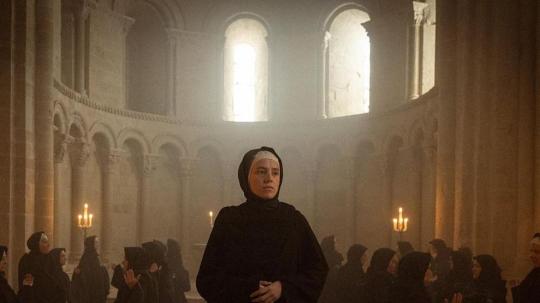
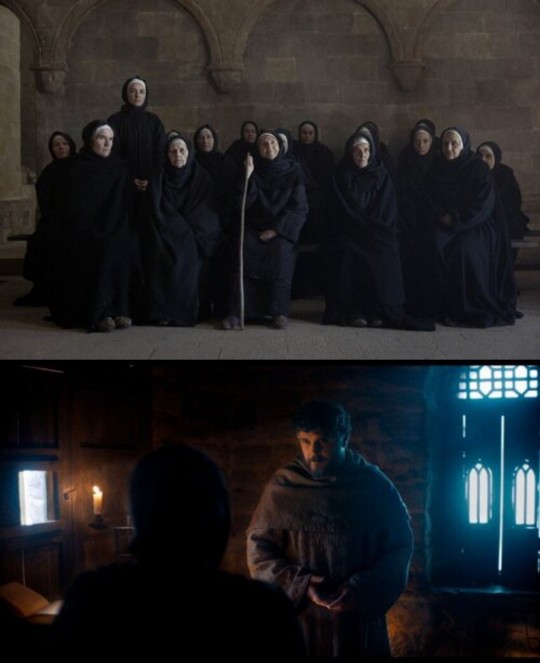
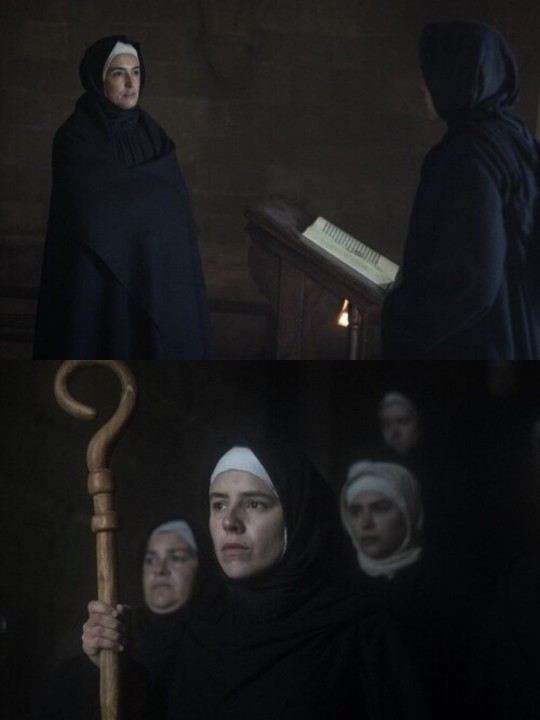
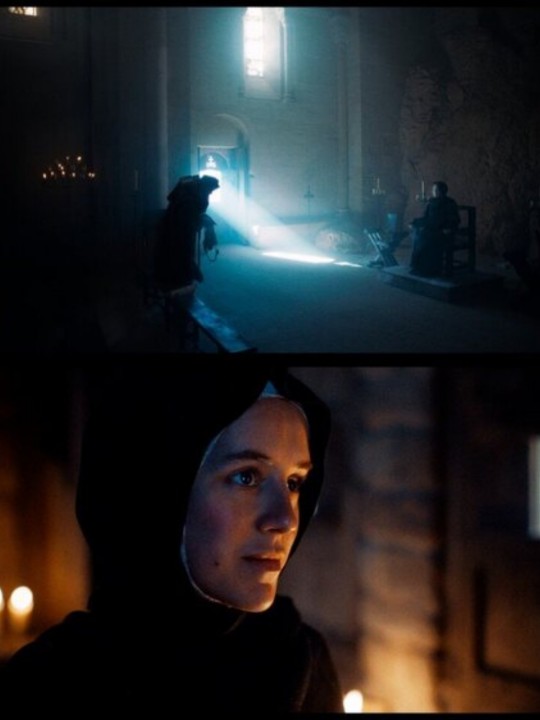
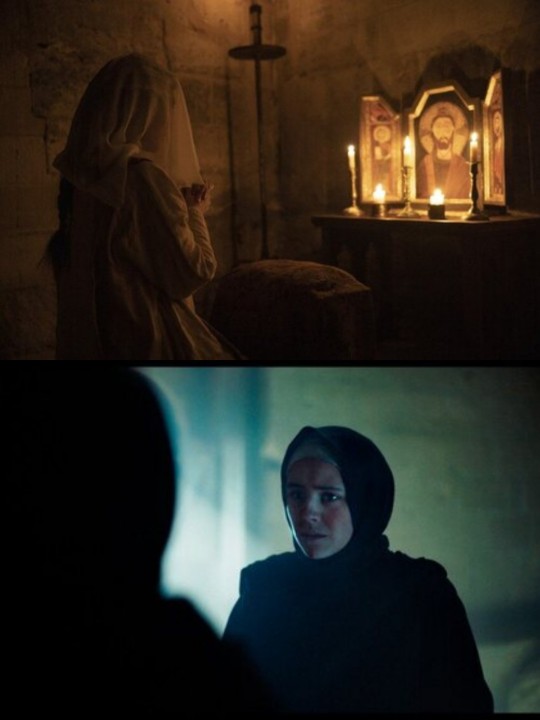



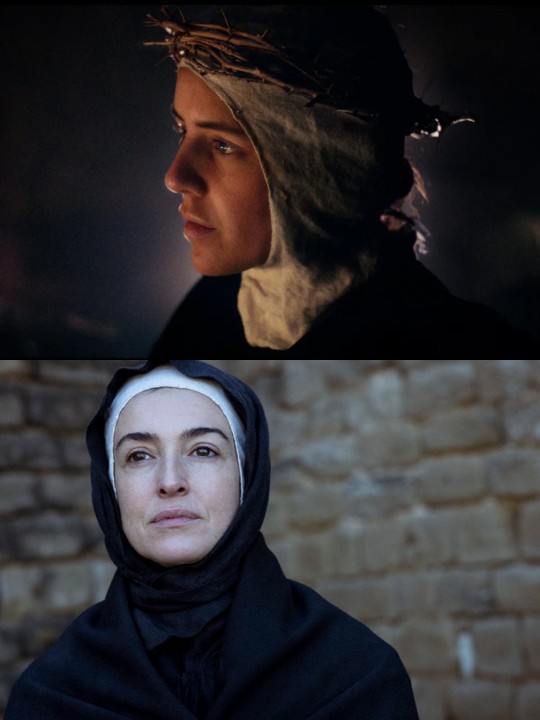
Poster
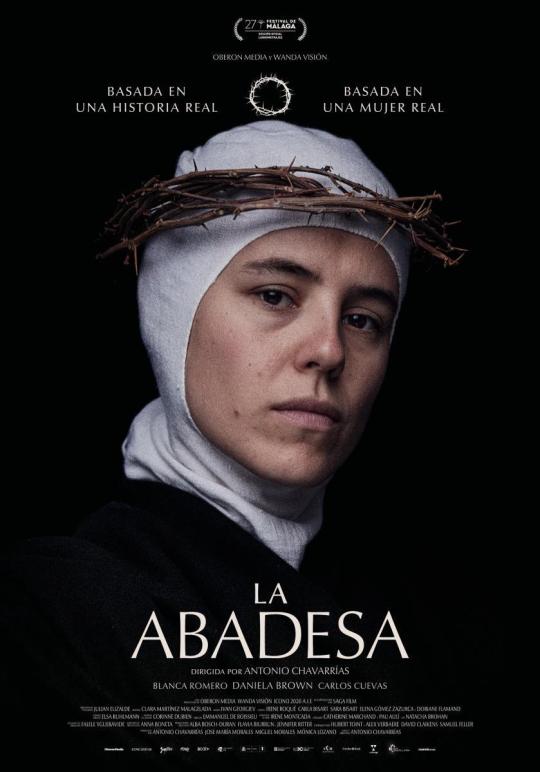
(Based on a true story/ Based on a true woman)
#the abbess#la abadesa#la abadesa 2024#period dramas#films#emma of barcelona#guifré ii borrel of barcelona#bishop gotmar of vic#antonio chavarrías#daniela brown#blanca romero#carlos cuevas#ernest villegas#oriol genís#joaquín notario#anäel snoek#9th century#berta sánchez bajona#olivia auclair#emma de barcelona#guifré ii borrel de barcelona#guifré ii de barcelona#guifré ii of barcelona#guifré i of barcelona#guifré i de barcelona#guifré el pilós#Sant Joan de les Abadesses#siglo ix
9 notes
·
View notes
Text

On February 1st, 850, the King Ramiro I died. He inherited the crown from his relative Alphonse II the Chaste, who died without offspring. He had to face Vikings' attacks and tried to repopulate the city of León. During his reing, the famous and legendary battle of Clavijo took place.

During his reign, two famous buildings were constructed: the church of San Miguel de Lillo (above) and the Palace of St. Mary of Naranco (below).
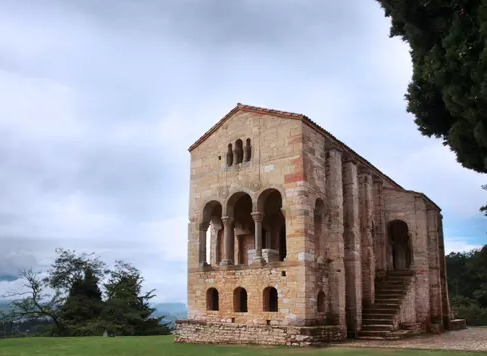
About the Vikings' attack (ES):
youtube
youtube
#Ramiro I de Asturias#Alfonso II el Casto de Asturias#Spain#History#Spanish History#Church of San Miguel de Lillo#Palace of St Mary of Naranco#Preromanesque#Middle Ages#Asturias#Youtube#La Coruña#Gijón#Clavijo#Apóstol Santiago#Leyendas#Pedro Marcio#Siglo IX#Voto de Santiago#Crónicas medievales#Ordoño I#Monte Laturce#Albelda#Ordoño II#Reconquista
1 note
·
View note
Text

#Villa Barbaro#es una villa palladiana en Maser# Treviso en la región del Véneto# Italia#La familia Barbaro es una antigua familia noble veneciana que ya ostentaba cargos en la República de Venecia en el siglo IX.
54 notes
·
View notes
Text
JOYA MEDIEVAL: La CIUDAD ABANDONADA de GRANADILLA

Situada al noroeste de la provincia de Cáceres, Granadilla es una ciudad abandonada incluida en el municipio de Zarza de Granadilla.
Por su pasado medieval y su entorno natural, Granadilla es (posiblemente) uno de los pueblos fantasma más bonitos que uno se puede encontrar a lo largo y ancho de la geografía española. Antiguo feudo medieval, esta localidad está situada al norte de la provincia de Cáceres.
Sus orígenes se remontan al siglo IX cuando los árabes fundaron la población en un enclave estratégico en la Vía de la Plata. En 1160 fue conquistada e incorporada al Reino de León. En el siglo XV, Granadilla pasó a manos de Fernando Álvarez de Toledo, primer duque de Alba, a cuya familia perteneció hasta el año 1830, manteniendo no obstante el castillo hasta 1893
#Sus orígenes se remontan al siglo IX cuando los árabes fundaron la población en un enclave estratégico en la Vía de la Plata. En 1160 fue c#Granadilla pasó a manos de Fernando Álvarez de Toledo#primer duque de Alba#Esta es la imagen y algunos datos ¡O no! la historia la pones tú (La tuya) ¿Lo harás?
14 notes
·
View notes
Text
Concierto con música de Boccherini
En el Palacio de Ajuda, de Lisboa, que aparece profusamente en la novela y concretamente en la Sala dos Serenins, la Orquestra Sem Fronteiras, interpreta la famosa: Música nocturna en las calles de Madrid de Luigi Boccherini. Una delicia.
youtube
View On WordPress
#Crónicas del conde de Peralada#El ix conde de Peralada#Jordi Martínez Brotons#Palacio de Ajuda#Siglo de las Luces#sINFONÍA aZUL pRUSI#Youtube
0 notes
Text

A sculpted image of Nyoirin Kannon Bodhisattva (如意輪観音菩薩) dating to the 9th century at Kanshinji Temple (観心寺) in Osaka
Una imagen esculpida del Bodhisattva Nyoirin Kannon (如意輪観音菩薩) que data del siglo IX en el templo Kanshinji (観心寺) en la ciudad de Osaka
Image from Image from "貞観彫刻 (日本の美術7)" [Jōgan Sculpture (The Arts of Japan 7] by 倉田文作 [Kurata Bunsaku], published by 小学館 [Shōgakukan], 1971, page 96
#japanese art#buddhist art#arte budista#arte japonés#如意輪観音菩薩#如意輪観音#nyoirin kannon#観音菩薩#観音#kannon#avalokitesvara#大阪市#osaka#観心寺#kanshinji#真言宗#shingon
31 notes
·
View notes
Text
“No hay sabiduría sin prudencia. No hay filosofía sin cordura”
Jaime Balmes

Jaime Balmes y Urpiá fue un filósofo, teólogo apologista, sociólogo y tratadista político español, nacido en el municipio español de Vich en agosto de 1810.
En 1817 inicia sus estudios en el seminario de Vich en donde estudio gramática latina, retórica y filosofía hasta 1822.
En 1825 inicia estudios de teología recibiendo el titulo en 1833.
En 1834 es ordenado sacerdote y continua sus estudios, obteniendo los títulos de Doctor en Sagrada Teología y bachiller en Cánones por la Universidad de Cervera.
Jaime Balmes impartió clases de matemáticas hasta el fallecimiento de su madre en 1839 y en 1841 se traslada a vivir a Barcelona.
Es a partir del año 1841 que el genio de Balmes estalla desarrollando una actividad frenética y portentosa en muy pocos meses, llegando a ser admirado en toda Europa por sus escritos y personalidad.
Durante los siguientes años Balmes produce numerosos artículos y en 1841 escribe La religion comparada al alcance de los niños y un año mas tarde “El protestantismo comparado con el catolicismo, en sus relaciones con la civilización”, considerada una gran obra de la filosofía de la historia.
Tras el fallecimiento de su padre en 1843, Balmes, fija su domicilio en Madrid en 1844 donde dirige su periódico y se convierte en el inspirador doctrinal del Partido Monárquico Nacional.
En 1845 publica El Criterio, su mejor y mas difundida obra. En 1847 publica su controvertida obra opúsculo Pio IX, viéndose sometido a una campaña de difamación el cual propició la publicación del Pensamiento de la Nación en el que desmontaba todas sus acusaciones y que algunos autores denominan como su Autobiografía.
Considerado el filósofo mas importante de la España del siglo XIX modernizando la escolástica, centrando el problema de la certeza y en el criterio de esta (conciencia, evidencia, e instinto intelectual).
Para Balmes, la lógica esta relacionada con muchas facultades del alma humana; “Una buena lógica, debiera comprender al hombre entero: porque la verdad está en relación con todas las facultades del hombre”.
Balmes distingue entre lógica natural y lógica artificial, en donde la lógica natural es la disposición que la naturaleza nos da para conocer la verdad, y la lógica artificial es el conjunto de las reglas que nos guían para conocer la verdad, y de las razones en que se fundan.
Jaime Balmes muere en julio de 1848 derivado de una enfermedad pulmonar tuberculosa.
Fuentes: Wikipedia, biografiasyvidas.com unirioja.es
#sociologo#filosofos#filosofo#notas filosoficas#frases de filosofos#teologos#teologia#españa#frase de reflexion#citas de filosofos#notas de filosofia#citas de la vida
8 notes
·
View notes
Text
EL CRIMINAL PORTUGUES DIEGO DA SILVA
Nuestra querida revista Edra nos trae una historia de superación del Guanarteme Engoynaga contra los invasores portugueses.
EDRA - Origen
FAITA FAITA VIRIRUNJUEN
En el siglo XV (c. 1460-1475) el capitán portugués Diego da Silva intentó invadir la ciudad de Gáldar (Gran Canaria), por el camino quemó poblados y asesinó a sus habitantes; pero derrotado por los canarios a las puertas de la ciudad de Gáldar y sin posibilidad de huir hacia los barcos, se encierra con parte de sus hombres en una amplia construcción hecha por los canarios que se encuentra a la entrada de la ciudad.
En este cerco, Diego da Silva se refugia de la justicia de los canarios durante algunos días en los que se encuentra sitiado por completo, hasta que una noche, el Guanarteme Engoynaga, apiadándose de él y de sus hombres decide perdonarles la vida, y para ello usa una estrategia, entrar con ellos en el cerco…
«A el instante que el rey canario se entró mesclado con los christianos fueron tantas las pedradas i los gritos que parecía día de juiçio no se podían, oir saltaron dentro de el sercado con sus astas, diciendo en su lengua 𝐇𝐚𝐢𝐭𝐚, 𝐡𝐚𝐢𝐭𝐚 𝐯𝐢𝐫𝐢𝐫𝐮𝐧𝐣𝐮𝐞𝐧, “Traición traición, mueran como aleves” o “traidores”, Guadartheme daba grandes voces i mandó que volviessen fuera por onde havían entrado, saliéronse todos, i quedaron otros de pie en la pared, mandolos vajar y tiraban de afuera algunos dardos que lastimaron a algunos soldados, juroles el rey que les quitaría las cavezas por Tis Tirma…».
[Marín de Cubas (1687, I: 37r) 2021: 212]
«[…] viendo la accion los Canarios, que havian suvidose sobre lapared, les tiraron pedradas y palos alos Xristianos con gran vocería, decian 𝐟𝐚𝐢𝐭𝐚, 𝐟𝐚𝐢𝐭𝐚 traicion, mueran los traidores; y luego Guadartheme, les juró por su caveza, que sino se aquietaban les quitaria la Vida, alos demandados».
[Marín de Cubas 1694, I, 16: 32v]
ℹ️ Propuesta de traducción: Faita, faita virirunjen. De Fayəḍ, fayəḍ, birirûn-ǝghǝwăn. “Daño o calamidad a los expatriados que vomitan”. [Ignacio Reyes Garcia (18.IX.2023)].
“El enunciado completo, con el (correcto) ajuste que incluye Marín en la versión de 1694, se restituiría: Faita, faita, virirunjuen o, en su versión analítica, Fayəḍ, fayəḍ, birirûn-ǝghǝwăn.
Por el contexto, donde se demanda la muerte de los extranjeros retenidos, acaso la mejor traducción para el sintagma inicial fayəḍ debería contemplar la literalidad del ‘daño’ que se reclama para ellos (imprecación).
Por lo que respecta a la caracterización de los extranjeros, la imagen que se invoca conjuga dos ideas muy significativas a través de una proposición simple, cabe presumir que lexicalizada. El sujeto expreso remite al nombre plural iburerăn, ‘hombres sin familia ni amigos, alejados de su casa o país’. Individuos que, según reza el verbo (*āhghŭh, *āwghŭh > əqqəw) en su (correspondiente) 3ª persona del plural ǝghǝwăn, ‘vomitan’, bien por la situación de peligro inminente para sus vidas o bien como representación más general de los viajeros que reaccionan así después de una larga travesía (o tal vez en alusión al empleo de las armas de fuego)”.
REFERENCIAS
📖 Tomás Marin de Cubas. Conquista de las Siete Yslas de Canaria (1687). Edición crítica de Antonio M. López Alonso (2021).
🌐 www.proyectotarha.org
🌐 www.imeslan.com
📷 Cuesta de Silva (1893). Fedac. El Guanarteme de Gáldar acompañado de guerreros canarios, imponiéndose a sus vasallos, condujo por la Cuesta de Silva al portugués y a los suyos hasta el lugar en que habían de embarcarse.


Ésta zona de la isla es conocida como el barranco de Silva, el puente de Silva y muchos años atrás como la Cuesta de Silva por lo adbruto del terreno al subir.
http://www.proyectotarha.org/?fbclid=IwAR3Oxplyw9CPYdLG-6gH6lTFFRLFy58vpftisOHkWXtO8VavxP7H62zJxRw
https://www.facebook.com/permalink.php?story_fbid=pfbid0HKCiqp4witNhiwxRMDzTT9ep3UM7qCKyhyGvf62cWsUj1XbxLhMrYnHnuu94e4tHl&id=100046478508495&__cft__[0]=AZUPD2mb9k9iphAvfFcwpRKKSqbViWEso9QIIjZdr-6MQkFAHnZusRR0IGR24CvkXi6RPpyPEowifAnalGbiwbQM0iqeypBmFJvidWJgBlYkj6LgjT2RjdM5M7YnSiyJVZcJaVscJjZfEMoYxGT-WwSQb1KThbYpMv1giCiuupalTp9zPGpth9ORgfjbSIVfXzc&__tn__=%2CO%2CP-R
#diego da silva#portugues#godo#guanarteme#engoynaga#aboriginal#aborigenous#indigenous#culture#history#genocide#native#unesco#united nations#canary islands#international criminal court#cou penal international#corte penal internacional#aborigenes#indigenas#cultura#historia#nativos#genocidio#naciones unidas#islas canarias#canarias la colonia mas antigua del mundo#canarias tiene identidad cultural propia#descolonizacion de canarias#canarias libre
11 notes
·
View notes
Text
Sean bienvenidos, japonistasarqueologicos a una nueva entrega de historia nipona en la que os explico la evolución del artefacto Tanegashima, una vez dicho esto pónganse cómodos, que empezamos.
-
Fue introducido por los portugueses en 1543, en pleno periodo Muromachi desde la isla que lleva su mismo nombre, el polvo negro químico fue inventado por los chinos en el siglo IX, se usaba para los fuegos artificiales, después se trasladó a otros ámbitos.
-
Se cuenta que cuando llegó a Japón, un herrero vendió a su hija para poder producir dicho artefacto, era un producto raro y poco efectivo, no todos los samuráis la utilizaban, ya que muchos preferían, todavía, las técnicas tradicionales más efectivas, además la consideraban un elemento deshonroso. El hecho más notable fue el 28 de junio de 1575 en Nagashino, en la Provincia de Mikawa. El clan de Oda Nobunaga se enfrentaba contra el clan Takeda conocido por su temible caballería, Oda Nobunaga emplearía unas empalizadas para proteger a sus soldados de las sucesivas cargas, en esta batalla se usaría el artefacto en masa. Esto lo podéis ver en el famoso videojuego de Total War: Shogun 2.
-
Esperó que os haya gustado y nos vemos en próximas publicaciones que pasen una buena semana.
-
日本の考古学者の皆さん、種子島の遺物の変遷を説明する新しい日本史へようこそ。 - 室町時代中期の 1543 年に、同じ名前の島からポルトガル人によって導入されました。化学黒色火薬は 9 世紀に中国人によって発明され、花火に使用されましたが、その後他の用途に移りました。地域。 - 彼が日本に到着したとき、鍛冶屋はその工芸品を製造できるように娘を売ったと言われています。それは希少で非効率な製品でした。多くの武士が依然として最も効果的な伝統的な技術を好んだため、すべての武士がそれを使用したわけではありません。彼らはそれを考慮しました不名誉な要素。 最も注目すべき出来事は、1575 年 6 月 28 日に三河国長篠で起こった。 織田信長の一族は、恐ろしい騎兵で知られる武田家と対峙しました。織田信長は連続突撃から兵士を守るために柵を使用しました。この戦いでは、アーティファクトが一斉に使用されました。 これは、有名なビデオ ゲーム Total War: Shogun 2 で見ることができます。 - 気に入っていただければ幸いです。今後の投稿でお会いしましょう。良い一週間をお過ごしください。
-
Welcome, Japanesearchaeologicalists, to a new installment of Japanese history in which I explain the evolution of the Tanegashima artifact. Having said that, make yourself comfortable, let's begin. - It was introduced by the Portuguese in 1543, in the middle of the Muromachi period from the island that bears the same name. The chemical black powder was invented by the Chinese in the 9th century. It was used for fireworks, then it moved to other areas. - It is said that when he arrived in Japan, a blacksmith sold his daughter to be able to produce said artifact. It was a rare and ineffective product. Not all samurai used it, since many still preferred the most effective traditional techniques. They considered it a dishonorable element. The most notable event was on June 28, 1575 in Nagashino, Mikawa Province. Oda Nobunaga's clan faced the Takeda clan, known for its fearsome cavalry. Oda Nobunaga would use palisades to protect his soldiers from successive charges. In this battle, the artifact would be used en masse. You can see this in the famous video game Total War: Shogun 2. - He hoped you liked it and see you in future posts, have a good week.


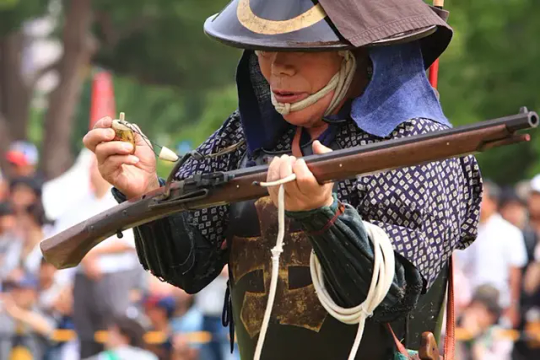
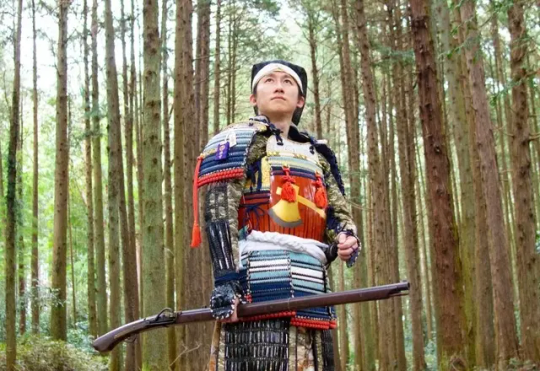


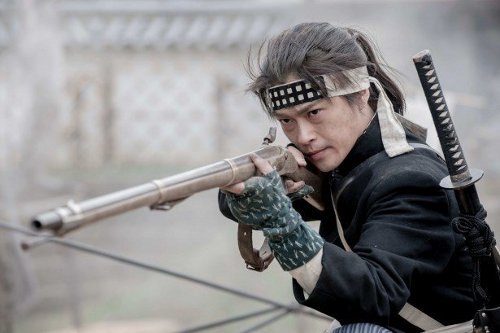
#Japan#History#China#Tanegashima#Hinawashu#NobunagaOgata#Kurantakeda#BattleofNagashino#MikawaProvince#NagashinoCastle#Portugal#MuromachiPeriod#VideoGame#TotalWarShogun2#-#日本#歴史#中国#種子島#日奈和州#緒方信長#倉武田#長篠の戦い#三河#長篠城#ポルトガル#室町時代#ビデオゲーム
18 notes
·
View notes
Text
Basílica de S. Marco, s. IX
The Basilica of St Mark, 9th century
Basilica di S. Marco, s.IX

(English / Español / Italiano)
The Basilica of St Mark is the main church of the city of Venice, built to honor the relics of St. Mark the Evangelist.
The relics were stolen from Alexandria of Egypt in 828 AD by two Venetian merchants thanks to a stratagem: hidden in a basket of vegetables and pork.
The original church was progressively enriched with columns, friezes, marbles, sculptures, and gold brought to Venice on merchant ships coming from the east. A law of the Venetian Republic stipulated as a tribute that lucky merchants, after doing profitable business, should make a gift to embellish St. Mark's. Hence the variety of styles and materials.
The loot of the sack of Constantinople during the Fourth Crusade (1204), in particular, enriched the treasure of the basilica, which was thus completed in the 13th century together with the splendid golden mosaics decoration.
*****
La Basílica de San Marcos, la iglesia principal de Venecia, fue construida para honrar los restos de San Marcos Evangelista.
Los restos fueron robados en Alejandría de Egipto en 828, por dos comerciantes venecianos, gracias a un estratagema: escondidos en una canasta de hortalizas y carne de cerdo.
La iglesia original fue progresivamente enriquecida con columnas, frisos, mármoles, esculturas y oro llevados a Venecia en los barcos de los comerciantes que venían de oriente. Una ley de la República Veneciana imponía como tributo que los mercaderes afortunados, después de haber hecho los negocios provechosos, hicieran un regalo para embellecer San Marcos. De ahí la variedad de estilos y materiales.
El botín del saqueo de Constantinopla, en la cuarta cruzada ( 1204), en particular, enriqueció el tesoro de la Basílica que se terminó, finalmente, en el siglo XIII junto con la hermosa decoración de mosaicos dorados.
*****
La Basilica di San Marco è la chiesa principale della città di Venezia, costruita per onorare le spoglie di San Marco Evangelista. Le spoglie furono trafugate da Alessandria d'Egitto nel 828 da due mercanti veneziani grazie ad uno stratagemma: nascoste in una cesta di ortaggi e di carne di maiale.
La chiesa originaria fu progressivamente arricchita di colonne, fregi, marmi, sculture, ori portati a Venezia sulle navi dei mercanti che arrivavano dall'oriente. Una legge della Repubblica Veneziana imponeva come tributo che i mercanti fortunati, dopo avere fatto gli affari vantaggiosi, facessero un regalo per abbellire San Marco. Da qui la varietà di stili e materiali.
Il bottino del sacco di Costantinopoli nel corso della Quarta Crociata (1204), in particolare, arricchì il tesoro della basilica che fu così terminata nel XIII secolo assieme alla splendida decorazione a mosaici dorati.
photo: @_electronaut_
fuente: tesori_italiani
#venice#venezia#venecia#san marco#s.IX#9th century#13th century#s. XIII#arte bizantino#byzantine art
3 notes
·
View notes
Text
GENESIS 1:26-27
Hecho a su imagen y semejanza
En 1979, se desenterró una estatua de dos metros de altura de un hombre barbudo en el yacimiento de Tell Fakhariyeh, en Siria. La estatua, con una larga vestimenta envuelta, tenía las manos fuertemente unidas a la cintura. Era sin duda un miembro de la realeza. La estatua era del siglo IX a.C. y representaba a un rey, un miembro de la clase dirigente asiria.
Pero, hay un giro fascinante en este descubrimiento, la estatua tenía una inscripción bilingüe. En dicha inscripción en arameo destacan dos palabras. La estatua se describe a sí misma como "imagen" y "semejanza" del gobernante original, las mismas palabras utilizadas en el pasaje de hoy para describir nuestra relación con Dios.
La estatua fue —según sus propias palabras— hecha a imagen del rey. Fue tallada a propósito para representar y reflejar al soberano real que la encargó; una extensión tangible de su gobierno y dominio.
Es un fragmento apasionante del contexto antiguo.
Esta estatua puede ayudarnos a visualizar lo que quiere decir el Génesis cuando declara que estamos hechos a imagen de Dios, y esto es realmente importante. Ser un portador de la imagen real es una pieza fundamental de nuestro rompecabezas de identidad. Es lo que nos hace únicos entre la creación de Dios; lo que nos da nuestro valor, dignidad y estima.
Cuando la Biblia dice que hemos sido creados a imagen de Dios, está describiendo a la humanidad en los mismos términos que la estatua real de la antigüedad. Somos una representación tangible y un reflejo de aquel que nos creó. Llevamos su impronta real; somos portadores de su santa esencia.
Sin embargo, ahí es donde la analogía de la estatua toca techo. Porque, a diferencia de la escultura de piedra, no somos un ídolo inanimado, creado por una mano humana imperfecta. Por el contrario, somos hijos de Dios que vivimos y respiramos, creados por el Padre celestial. Es decir, Dios mismo ha soplado su vida abundante en ti.
Esta impresionante realidad es tu verdad de hoy:
Eres una obra maestra creada a imagen de Dios mismo.
En Cristo, has sido restaurado y liberado para representar y reflejar a Jesús al mundo.
A estas alturas, probablemente te estés preguntando qué significa todo esto. Bueno, déjame compartirte algunos pensamientos.
Si estás hecho a imagen de Dios, entonces eres portador de su creatividad. Dentro de ti está el eco del arte de tu Creador, la chispa de una imaginación capaz de dar forma a mundos, culturas y vidas para su gloria.
Si estás hecho a imagen de Dios, estás diseñado para vivir conectado. Al igual que el Padre, el Hijo y el Espíritu Santo existen en amorosa comunidad unos con otros, tú también estás hecho a imagen del amor desbordante. Has nacido para dar y recibir amor. Te lo mereces.
Si estás hecho a imagen de Dios, tienes un valor infinito. Así como el valor de un diamante no está determinado por su tamaño, sino por su belleza y rareza inherentes, así también es tu valor. No eres definido por tus logros, sino por el hecho mismo de tu existencia.
Eres la obra maestra de Dios, su imagen y semejanza. Aférrate hoy a este maravilloso conocimiento.
3 notes
·
View notes
Text
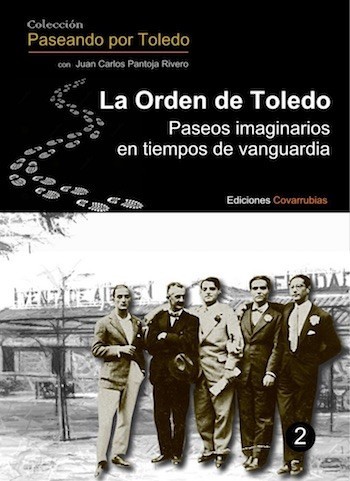


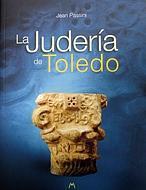
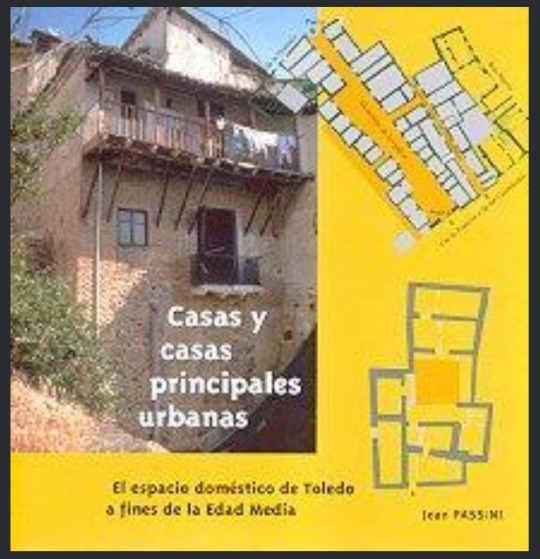


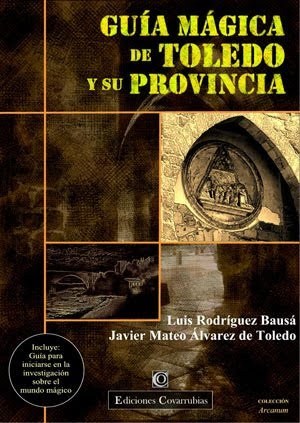


Propaganda
1. La Orden de Toledo: Paseos imaginarios en tiempos de vanguardia (The Order of Toledo: Imaginary walks in avant-garde times)
Author: Pantoja Rivero, Juan Carlos
Editorial: Covarrubias Ediciones
Edition: 2019
Synopsis: The Order of Toledo was, above all, an avant-garde fantasy of the brilliant film director Luis Buñuel, who knew how to infect his friends from the Generation of '27 to the Spanish intellectuality of the first third of the 20th century. Together, they dedicated themselves to living Toledo as if it were the great stage of a surrealist montage, in an artistic (or anti-artistic and irational) contrast with the monumentality and historical past of the old dead city.
(Well, in my blog I have been making posts about The Order of Toledo and the book is a valuable source)
2. Toledo: La ciudad de los muertos (Toledo: The city of the dead)
Author: Leblic García, Ventura
Editorial: Covarrubias Ediciones
Edition: 2013
Synopsis: Toledo. A large historical necropolis where Carpetans, Romans, Visigoths, Muslims, Jews and Christians rest...their rites around death, beliefs, customs, evolution of the cemetery spaces...
(I have posted the scans of the first pages of this books and I'm planning to keep on posting them but I wanted to know if you want scans from another book)
3. De Mayrit a Madrid: Madrid y los árabes del siglo IX al siglo XXI (From Mayrit to Madrid: Madrid and the Arabs from the 9th century to the 21st century)
Editors: Madrid. Casa Árabe e Instituto Internacional de Estudios Árabes y del Mundo Musulmán ; Barcelona ; Madrid: Lunwerg
Edition: 2011
Synopsis: This work deals with the Arab-Islamic past (Andalusian, Mudejar and Moorish) of Madrid and its forgotten heritage since it is the only European capital whose origins and name are linked to Arabic.
Revisiting that past and making it known is the objective of this work, which wants to rescue knowledge of a relationship between Madrid and the Arabs that does not end in the Middle Ages, since the town and court maintained various links with what was over time. Arab through diplomatic delegations, Arab figures welcomed by the city, valuable collections of manuscripts and numismatics, a romantic architectural taste that seeded the city with unique neo-Islamic buildings or Hispano-Arab scientific and cultural institutions. And, finally, the cosmopolitan and intercultural reconversion of the city has made it the recipient of a new Arab and Muslim immigration that once again gives human visibility to this relationship between Madrid and the Arab.
4. La Judería de Toledo (The Jewish Quarter of Toledo)
Author: Passini, Jean
Editorial: Ediciones del Sofer
Edition: 2014
Synopsis: The work reveals the vestiges of the areas of medieval Toledo Jewry and its history. It collects a topographical reading of its evolution and offers the main elements through maps, plans and high-quality color photographs.
5. Casas y casas principales urbanas : el espacio doméstico de Toledo a fines de la Edad Media (Houses and main urban houses: the domestic space of Toledo at the end of the Middle Ages)
Author: Passini, Jean.
Editor: Toledo. Universidad de Castilla-La Mancha
Edition: 2004
Synopsis: This work is an extension of previous research on different districts, and seeks, for the city as a whole, to “understand the genesis of medieval urban space, to follow its transformations and successive reappropriations” , mainly with the aim of understanding, for one of the ancient provincial capitals of al-Andalus, the modalities of the transition from the Muslim city of the end of the eleventh century (time of its occupation by the Christians) to the Castilian city of the end of the Middle Ages. The main documentary basis of the work is a very important and very detailed inventory of the real estate of the Cathedral Chapter, an inventory carried out in 1491-1492, which covers a considerable heritage of 557 various buildings located in 64 sites or districts. The identification and location of houses, shops, mesones or fondouks and other urban buildings, often difficult on the current plot, has however resulted in the careful study of more than half of these old buildings. The systematic comparison of the text from the end of the Middle Ages with the remains still visible above ground or underground (and this very meticulous and patient work in the cellars of current Toledan houses is one of the great originalities of the research of Jean Passini) gave the results which are presented in this latest publication.
6. España medieval : el origen de las ciudades (Medieval Spain: the origin of the cities)
Authors: Novoa Portela, Feliciano; Villalba Ruiz de Toledo, F. Javier
Editors: Barcelona ; Madrid : Lunwerg, D.L.
Edition: 2012
Synopsis: A fascinating essay that will teach us to look at and understand our cities better. In the pages of this essay we will analyze the Roman origins, the Islamic, Christian and European influences to discover the cultural melting pot that marks the Spanish urban legacy, without forgetting some disappeared cities that tell us their history through archaeological remains.
7. Valle-Inclán y el insólito caso del hombre con rayos x en los ojos
(Valle-Inclán and the unusual case of the man with x-rays in his eyes)
Editors: Madrid. La Felguera
Edition: 2014
Synopsis: In 1923, a piece of news sparked great controversy among intellectuals, journalists and scientists. Joaquín Argamasilla, a young descendant of a family of aristocrats, claimed to have x-ray vision that allowed him to see through opaque bodies. The controversy, which divided half the country between defenders and detractors of the strange case, reached the highest circles. In April, at the initiative of Queen María Cristina, a commission was established to study the case, chaired by Ramón y Cajal. Valle-Inclán came to Argamasilla's defense and the great Harry Houdini challenged him to a public demonstration in New York.
(Joaquín Argamasilla, Harry Houdini, Valle-Inclán, Ramón y Cajal... yep, we're thinking the same, episode 2xO6, Tiempo de Magia, from El Ministerio del Tiempo, if anyone wants to learn more about this topic this book is good)
8. Guía mágica de Toledo y su provincia (Magical guide to Toledo and its province)
Authors: Rodríguez Bausá, Luis; Álvarez de Toledo, Javier Mateo
Editorial: Ediciones Covarrubias
Edition: 2010
Synopsis: Saramago wrote that traveling should be a matter of another matter, staying more and walking less; and a little later he added that it is not good to stay for only a quarter of an hour next to a construction that is seven hundred years old. The authors agree with such appropriate phrases, and that is why they have written this route, this uneven guide, this compilation of events, in short, so that the traveler stops in a multitude of towns that only sounded like transit and never like stop and inn. Because the truth is that the city of Toledo and its province discreetly hide a large number of enclaves that deserve to be savored by the five senses, and in which one must rest until the memory is macerated. This is what this work talks about: caves, sacred mountains, magical wells, rainy images, enchanted fountains or thunderous miracles... but, above all, towns, cities and regions; yes, with order and a taste of dissidence and heterodoxy.
Also included is what the authors have called "Beginner's Guide", a brief but rigorous approach to the magical phenomenon, something like an index so that whoever wants it, has the basic premises to get started in the world of research on these issues.
9. AL-ANDALUS. Ocho siglos de civilización musulmana que marcaron la historia y la cultura de España (AL ANDALUS. Eight centuries of Muslim civilization that marked the history and culture of Spain)
Author: Masiá, Concha
Editorial: ALBA
Edition: 2006
Synopsis: "In the year 711, the Muslims arrived in the Iberian Peninsula. They called the vast territory where they settled for 800 years, from Tarifa to the Pyrenees, from the Levant to Portugal, al-Andalus. With their lights and shadows, these eight centuries of Muslim civilization, configuring many aspects of our personality as a people and as a culture, to which we Spaniards of the 21st century are still indebted"
This book and the following two books are like a triology about Al Andalus. This first one collects information about the different periods, states, events and some of its rulers throughout the history of Al Andalus.
10. AL-ANDALUS. Personajes históricos (AL ANDALUS. Historical figures)
Author: Masiá, Concha
Editorial: Albor Libros, Madrid
Edition: 2011
Synopsis: "A general vision of al-Andalus, from the 8th century to the 17th century, through its most prominent characters and also through less known, although no less important, people. Both of them reveal the splendor and glory of the imperishable Andalusian legacy"
This book gathers information about divers people from different states and periods throughout the history of Al Andalus: emirs, caliphs, politicians, religious leaders, warriors, scholars, artists, philosophers, poets...
11. AL-ANDALUS. 800 años de lucha (AL ANDALUS. 800 years of struggle)
Author: Masiá, Concha
Editorial: Albor Libros, Madrid
Edition: 2011
Synopsis: "In the year 711, the Muslims arrived in the Iberian Peninsula. They called the vast territory where they settled for 800 years, from Tarifa to the Pyrenees, from the Levant to Portugal, al-Andalus. With their lights and shadows, these eight centuries of Muslim civilization, configuring many aspects of our personality as a people and as a culture, to which we Spaniards of the 21st century are still indebted"
This book offers a view on the warfare, battles and military campaigns from different periods and states throughout the history of Al Andalus.
12. 20 grandes obras de 20 autores andalusíes (20 great works by 20 Andalusian authors)
Author: Lirola Delgado, Jorge
Editorial: FUNDACIÓN IBN TUFAYL DE ESTUDIOS ARABES
Edition: 2014
Synopsis: Selection of 20 Andalusian authors and 20 works from the different periods of al-Andalus. The book offers a biography of each author and a detailed description of the work.
#bookblr#books#history#polls#history books#spanish history#al andalus#la orden de toledo#paseos imaginarios en tiempos de vanguardia#toledo: la ciudad de los muertos#de mayrit a madrid#madrid y los árabes del siglo IX al siglo XXI#la judería de toledo#casas y casas principales urbanas#el espacio doméstico de Toledo a fines de la Edad Media#españa medieval : el origen de las ciudades#valle-inclán y el insólito caso del hombre con rayos x en los ojos#guía mágica de toledo y su provincia#AL-ANDALUS. Ocho siglos de civilización musulmana que marcaron la historia y la cultura de España#AL-ANDALUS. Personajes históricos#AL-ANDALUS. 800 años de lucha#20 grandes obras de 20 autores andalusíes#sefarad#madrid#toledo#the order of toledo#The Order of Toledo: Imaginary walks in avant-garde times#Toledo: The city of the dead#From Mayrit to Madrid#Madrid and the Arabs from the 9th century to the 21st century
9 notes
·
View notes
Text

La rebelión por los altos impuestos: Etienne Marcel y el Delfín de Francia, por Lucien Melingue.
#Pintura#Siglo XIX#pintura historicista#Carlos V de Francia#Luis IX de Francia#Preboste de París#Edad Media#Siglo XIV#Carlos II el Malo de Navarra#Guerra de los Cien Años
0 notes
Text
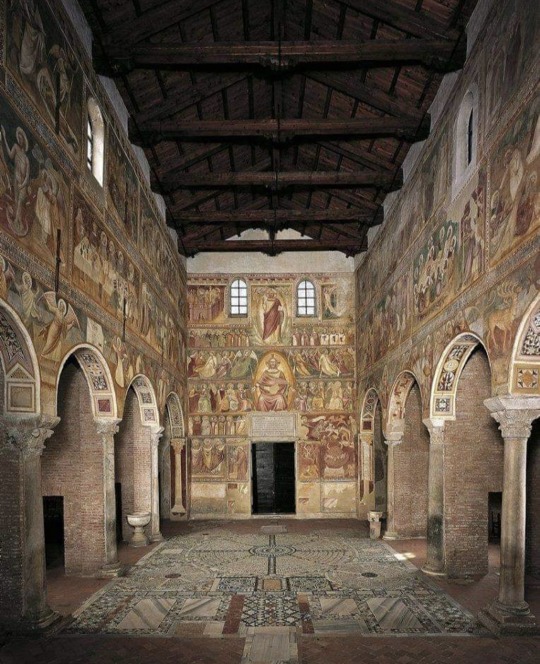
#Abadía de PomposaIdioLa abadía de Pomposa#situada en el municipio de Codigoro#en la provincia de Ferrara#es una abadía del siglo ix.
7 notes
·
View notes
Text
JOYA MEDIEVAL: La CIUDAD ABANDONADA de GRANADILLA

Situada al noroeste de la provincia de Cáceres, Granadilla es una ciudad abandonada incluida en el municipio de Zarza de Granadilla.
Por su pasado medieval y su entorno natural, Granadilla es (posiblemente) uno de los pueblos fantasma más bonitos que uno se puede encontrar a lo largo y ancho de la geografía española. Antiguo feudo medieval, esta localidad está situada al norte de la provincia de Cáceres.
Sus orígenes se remontan al siglo IX cuando los árabes fundaron la población en un enclave estratégico en la Vía de la Plata. En 1160 fue conquistada e incorporada al Reino de León. En el siglo XV, Granadilla pasó a manos de Fernando Álvarez de Toledo, primer duque de Alba, a cuya familia perteneció hasta el año 1830, manteniendo no obstante el castillo hasta 1893
#Sus orígenes se remontan al siglo IX cuando los árabes fundaron la población en un enclave estratégico en la Vía de la Plata. En 1160 fue c#Granadilla pasó a manos de Fernando Álvarez de Toledo#primer duque de Alba#Esta es la imagen y algunos datos ¡O no! la historia la pones tú (La tuya) ¿Lo harás?
6 notes
·
View notes
Text
Presentación de Sinfonía Azul Prusia en Lleida
Con motivo de las fiestas de San Jordi y Día del Libro, presentaré la novela en la Casa de Aragón en Lleida.
Será en la CASA DE ARAGÓN, en Gran Passeig de Ronda, 4, 25002 Lleida

View On WordPress
#Azul de Prusia#Carlos III#cASA DE aRAGÓN EN lLEIDA#Casa de Aragón#Crónicas del conde de Peralada#El ix conde de Peralada#Ferran Rocabertí y Boixadors#Jordi Martínez Brotons#Jordi Siracusa#Luis Borbón Farnesio#Presentación el lLEIDA#Siglo de las Luces
1 note
·
View note